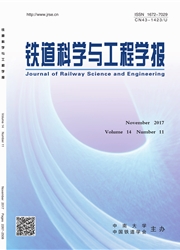

 中文摘要:
中文摘要:
合理预测客运量是铁路部门制定列车开行方案及组织管理的基础,为降低传统预测结果误差较大带来的决策风险,基于系统动力学,分析影响客运量的主要因素,利用逐步回归方法提取了GDP、铁路营业里程和民用汽车拥有量3个关键自变量,运用模糊多元回归预测理论,建立铁路客运量中长期预测模型,相应客运量的值由传统单一值变为区间值,函数图像变为“带”状,这种结果更加符合不确定环境下的实际情况。根据国家统计局公布的1990—2012年中国铁路相关数据,对模型的拟合效果进行了检验,并以2013年的数据为依据对客运量进行预测。结果表明:1990—2012年各拟合中心值与实际值误差均在5%以内,且实际值对拟合区间值的隶属度均在0.5以上,2013年预测中心值与实际值误差为4.74%且实际值在预测区间之内。
 英文摘要:
英文摘要:
Reasonable prediction of passenger traffic volume is the basis for making train operation plan, organization and management for the railway department. In order to decrease the decision risk caused by traditional prediction result, this paper analyzed the main factors affecting passenger traffic volume based on system dynamics. GDP, railway mileage and the number of civilian car ownership were selected as independent variables using the stepwise regression theory. A predicting method based on fuzzy multiple regression was proposed to establish for predicting the long - term railway passenger volume. It could make the prediction passenger traffic volume change from a traditional single value to interval value and turn the function of the image into a ribbon, which shows a better agreement with the actual situation under uncertainty environment. Some testing work for the fitting effect of the model was done based on the data published by National Bureau of Statistics in China from 1990 to 2012 and forecast passenger traffic volume in 2013. The results show that the errors between the fitting center values and the actual ones are all under 5% while the degree of membership of actual value are all above 0.5 from 1990 to 2012. The error is 4.74% between the prediction center value and the actual one while the actual value is in the prediction interval value in 2013.
 同期刊论文项目
同期刊论文项目
 同项目期刊论文
同项目期刊论文
 期刊信息
期刊信息
